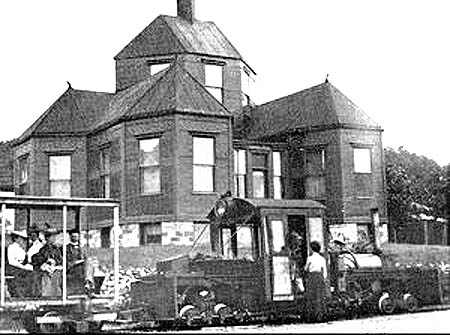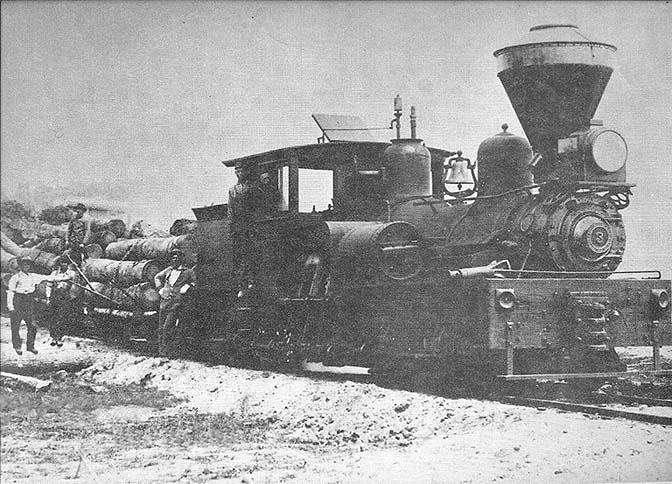

Ephraim Shay opearated a lumbering business near Harbor Springs, Michigan back in the days when the White Pine of the lower Peninsula was in great demand. You may not know it, but a great deal of Michigan Pine was used to rebuild Chicago after Mrs. O'Leary's cow became a bit fractious and burned the metropolis to the ground.
When you cut timber, you have to haul the logs off to a mill for processing into lumber. Mr. Shay owned a railroad, the Hemlock Central, which ran between Harbor Springs and the areas where trees were being sawn. Northern Michigan, at the time, was criss crossed by many logging railroads which were hurriedly built, with rough trackage, extremely sharp curves and steep grades.
Mr. Shay discovered that ordinary steam locomotives, due to their rigid frames, were not well adapted to bouncing along hastily constructed roadbeds. Consequently, the engines had an annoying habit of jumping the track. Out in the woods, it wasn't easy to re-rail a heavy locomotive. Another drawback of the ordinary steam engine was that it lacked the ability to pull heavy loads at the slow speeds required by poor quality trackage.
In order to circumvent these problems, Ephraim Shay, an inventive sort of fellow, came up with a logging locomotive which was a strange critter indeed. As you can see from this illustration, a Shay engine was built somewhat like a flatcar with a boiler mounted on it. You will note that it has flexible railway trucks beneath the body and rather small wheels, unlike the large drivers of ordinary locomotives which are cranked by side rods.
Also, instead of two horizontal cylinders up front, pushing the rods with steam, Shay used two or three vertical cylinders just ahead of the cab. Crank shafts connected these cylinders to a flexible drive shaft which ran alongside the engine and powered the the truck wheels with beveled gears.
Because of this arrangement, the trucks could move independently and twist and turn, just like the trucks of freight and passenger cars. Even on very rough track, the Shay locomotives had little difficulty following a poorly constructed roadbed. Another unusual feature of Shay Locomotives was that their boilers were not mounted in the center of the locomotive body, but were situated some 15" to the left of center in order to make room for the vertical cylinders ahead of the cab.
Although Mr. Shay invented this type of locomotive, he constructed only a few, himself. Most of the Shays used throughout the world were built by the Lima Machine Works, later known as The Lima Locomotive Works, in Lima, Ohio and were appropriately referred to as Lima Shays. They were not only used for logging, but also in mining operations and on Hawaiian sugar plantations...in fact wherever a powerful sure footed slow moving engine might be required. Although developed in the late 19th Century, Shays were built by Lima well into the first half of the 20th Century.
Further information concerning gear driven steam locomotives is available on the web page of MARK ROLLINS.

Photo courtesy SHAY LOCOMOTIVES.COM
On pleasant summer Sunday afternoons Mr. Shay would haul his fellow Harbor Springs residents on excursions out into the surrounding countryside aboard his Hemlock Central R.R. One such trip, with passengers aboard cars pulled by Hemlock Central No. 2 appears above.
Mr. Shay seemed especially fascinated with galvanized sheet metal. His Harbor Springs home was six sided, sort of a slighly compressed hexagon. The entire exterior was covered with embossed sheet metal. The walls were embossed to look like brick and the window frames were made to appear as stone. The heavy doors were sheathed with imitation carved wood. If you carefully examine the photo of his home behind the excursion train, you will be able to make out some of the embossing in the metal below the eaves of the house.
Mr. Shay even used galvanized sheet metal to build a steam yacht. Known as the AHA, it operated on Little Traverse Bay. The rusting hulk of the AHA was, for a number of years, on display at the Maritime Museum in Mackinaw City, Michigan.
North Manitou Island is located in Lake Michigan, about 12 miles by boat from the Leelanau Peninsula town of Leland. In 1908 lumbermen Smith and Hull laid out a railroad grade approximately six miles, overall, extending toward the northwest part of the Island. The TRAVERSE CITY EVENING RECORD of May 15, 1909 stated that the steamer NESSEN brought a 28 ton Shay locomotive (actually it was a 42 ton Shay [.ed]) and twelve Russell logging cars to the Island from Muskegon, Michigan. The NESSEN was heavily loaded with rails, and other railroad necessities on top of which was placed the locomotive. It was a risky venture which required calm weather. The railroad tracks were installed, a square engine house was built and the train was named the "Manitou Limited". A wood burning Shay pulled the cars of logs. A photo of the "Manitou Limited" on the old railroad grade near Davenport Camp some time between 1909 and 1915 can be seen by VISITING SHAY LOCOMOTIVES.COM.

The inked caption on this photo says, "First train load of logs drawn on the Manitou's. July 12, 1909." This is a bit puzzling, because Smith and Hull's "Manitou Limited" supposedly used locomotive No. 1. The engine in this photo bears a No. 3.
Apparently, the Manitou engine was sent to Virginia in 1915, after the Smith and Hull Mill closed down. Much of the foregoing information is contained in Rita Hadra Rusco's book, NORTH MANITOU ISLAND, Between Sunrise and Sunset.
If you wish to see more Michigan Area Railroad Pictures GO TO THE NEXT PAGE.
Otherwise you may return to my
HOME PAGE